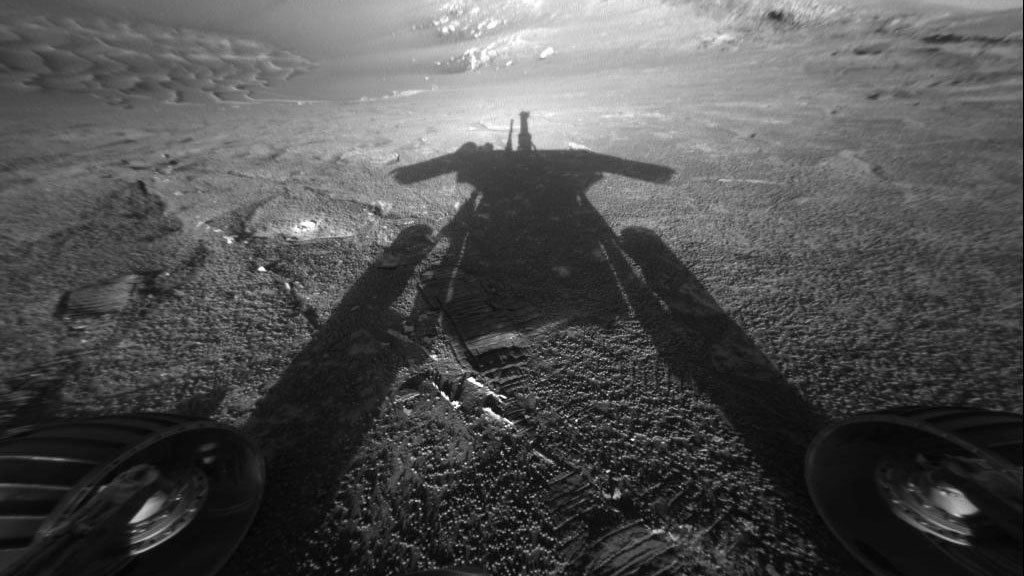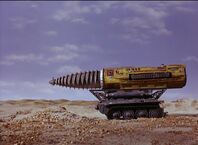|
|
Post by jandl100 on Jan 11, 2019 18:59:50 GMT
Chinese moon lander video of landing
|
|
|
|
Post by jandl100 on Feb 5, 2019 7:11:39 GMT
|
|
|
|
Post by jandl100 on Feb 12, 2019 18:53:24 GMT
|
|
|
|
Post by jandl100 on Feb 14, 2019 7:43:58 GMT
Fare well, Opportunity Rover on Mars - you rather exceeded expectations! 15 Earth years rather than the planned 90 days. Not bad at all!  www.jpl.nasa.gov/news/news.php?feature=7333&utm_source=iContact&utm_medium=email&utm_campaign=nasajpl&utm_content=daily-20190213-4 www.jpl.nasa.gov/news/news.php?feature=7333&utm_source=iContact&utm_medium=email&utm_campaign=nasajpl&utm_content=daily-20190213-4Going boldly where no-one had gone before. <iframe width="15" height="15" style="position: absolute; width: 15px; height: 15px; z-index: -9999; border-style: none; left: 5px; top: 70px;" id="MoatPxIOPT0_37091431" scrolling="no"></iframe> <iframe width="15" height="15" style="position: absolute; width: 15px; height: 15px; z-index: -9999; border-style: none; left: 689px; top: 70px;" id="MoatPxIOPT0_64633191" scrolling="no"></iframe> <iframe width="15" height="15" style="position: absolute; width: 15px; height: 15px; z-index: -9999; border-style: none; left: 5px; top: 755px;" id="MoatPxIOPT0_25668331" scrolling="no"></iframe> <iframe width="15" height="15" style="position: absolute; width: 15px; height: 15px; z-index: -9999; border-style: none; left: 689px; top: 755px;" id="MoatPxIOPT0_76319505" scrolling="no"></iframe>   |
|
|
|
Post by jandl100 on Mar 6, 2019 6:49:35 GMT
Back to INSIGHT lander on Mars. Oops. Looks like someone might have goofed. Drilling has started and they may have hit a stone or rock 50cm down that the drill can't get past. The Plan was to reach a depth of 3 to 5m. The 'goof' aspect [imo] is that the drill is not retractable; they can't lift it out, swing it round and have another try in a different location. They send this high tech marvel millions of miles at a cost of billions and it seems it's a 1-shot wonder. Oops. They'll be having another go to see if persistence will get past the obstacle. But a major part of the mission - measuring heat flow in Mars' interior - might be f*cked. They still have the seismometer working ok, as far as I know. www.gizmodo.co.uk/2019/03/insight-landers-drill-got-stuck-on-a-rock-during-its-first-dig-into-mars/Fingers crossed they can manage to complete the drilling to a useful depth. |
|
|
|
Post by MartinT on Mar 6, 2019 7:15:41 GMT
So what was the plan for the end of the drilling phase? How would the measuring device be put down the hole?
|
|
|
|
Post by jandl100 on Mar 6, 2019 7:23:54 GMT
A high tech ribbon is attached to the drill with temperature sensors all along its length, so the drill itself takes the measuring device down.
|
|
|
|
Post by MartinT on Mar 6, 2019 7:59:21 GMT
Clever.
|
|
|
|
Post by jandl100 on Mar 7, 2019 6:34:25 GMT
"Back in February, the Hayabusa2 spacecraft touched down on asteroid Ryugu to collect samples for scientists back home. Now, Japan Aerospace Exploration Agency (JAXA) has released a video of the brief contact between the probe and its target asteroid taken by a small on-board camera. It shows the moment Hayabusa2 fired a bullet into Ryugu's surface to kick up dust and fragments it can grab -- something the probe was supposed to have done back in October 2018 if not for the fact that the asteroid has much bigger gravel than its ground team expected.
Hayabusa2 has been orbiting Ryugu since mid-2018 to find the perfect spot for its touchdown. It took over a day for the probe to descend from its orbit, but the contact itself lasted only for a second."
|
|
|
|
Post by MartinT on Mar 7, 2019 6:50:42 GMT
That's quite a bounce. Amazing what has been achieved in remote probe technology in the last decade.
|
|
|
|
Post by jandl100 on Mar 13, 2019 6:49:58 GMT
|
|
|
|
Post by MartinT on Mar 13, 2019 6:54:44 GMT
That could so easily be this planet. Remarkable.
|
|
|
|
Post by jandl100 on Mar 21, 2019 8:37:24 GMT
|
|
|
|
Post by MartinT on Mar 21, 2019 9:15:33 GMT
It doesn't say whether they are due to tectonic activity or meteorite strikes?
|
|
|
|
Post by jandl100 on Apr 24, 2019 10:16:31 GMT
|
|
|
|
Post by jandl100 on May 2, 2019 7:12:44 GMT
|
|
|
|
Post by jandl100 on May 7, 2019 6:18:48 GMT
'Dust Cleanings Will Yield New Science The same winds that blanket Mars with dust can also blow that dust away. Catastrophic dust storms have the potential to end a mission, as with NASA's Opportunity rover. But far more often, passing winds cleared off the rover's solar panels and gave it an energy boost.' 'Dust clearings are also expected for Mars' newest inhabitant, the InSight lander. Because of the spacecraft's weather sensors, each clearing can provide crucial science data on these events, as well - and the mission already has a glimpse at that.' www.jpl.nasa.gov/news/news.php?feature=7394 |
|
|
|
Post by jandl100 on Jun 6, 2019 8:05:19 GMT
Remember the "Mole" drilling experiment that only managed to drill 12 inches rather than the hoped for 5 metres? Well, NASA engineers haven't given up. Latest article about their plans here -- www.jpl.nasa.gov/news/news.php?feature=7416&utm_source=iContact&utm_medium=email&utm_campaign=nasajpl&utm_content=daily-20190605-1One theory for the stoppage is, rather than a stone getting in the way, a lack of friction in the Martian soil due to its unusual makeup locally. They need to remove some gear with the robotic arm that is blocking the view from the camera so they can have a look, and maybe use the robot arm to press the soil down so as to compact it a bit and hopefully increase the friction allowing the Mole to dig deeper. They should send in International Rescue maybe?  |
|
|
|
Post by MartinT on Jun 6, 2019 11:17:56 GMT
Amazing that they can even contemplate remote repairs from another planet!
|
|
|
|
Post by jandl100 on Jun 24, 2019 7:29:27 GMT
Some recent observations by the Curiosity rover on Mars have shown unusually high methane levels. Reports from the popular media seem to be heavily stressing a possible biological source, but there seemed to be no mention of any of this from what I would consider a scientifically reliable media outlet. Until this morning, when NASA itself issued a press release -- www.jpl.nasa.gov/news/news.php?feature=7433&utm_source=iContact&utm_medium=email&utm_campaign=nasajpl&utm_content=daily-20190623-1"With our current measurements, we have no way of telling if the methane source is biology or geology, or even ancient or modern," said SAM Principal Investigator Paul Mahaffy of NASA's Goddard Spaceflight Center in Greenbelt, Maryland. Interesting, though, and it might be biological in origin. |
|